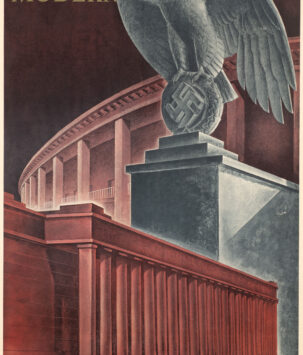Showing 25–36 of 53 results
-
Profilo continuo del Duce (Continuous profile of the Duce) from 1933 is a Futurist rendition of Mussolini’s distinctive side profile continuing a full 360 degrees. Futurism has been long associated with Fascism, with this sculpture, in its dynamism and movement, typifying Futurist works of art. It was approved as an official portrait by the Duce himself as one of many Futurist political artworks surrounding his cult of personality,
-
Josef Thorak’s sculpture, through its celebration of the triumphant hero, depicts the philosophical antithesis to the coddling liberal notion of celebrating and enabling mediocrity. Sports and athletics took on a national-political character in Nazi Germany, as the cultivation of one’s physical prowess was an indispensable facet in creating the utopian vision of a “New Man” who would harness the ultimate potential of the human race. This will for self-improvement is a central trait in Nietzsche’s concept of a “master-morality” which served as the foundation upon which all fascist ideologies based their political philosophies upon. Nazism, in all its Darwinistic tendencies sought to fashion a new national culture rooted in this so-called “master-morality” to supplant the prevailing Judeo-Christian “slave-morality”.
-
A large, imposing, period bronze eagle set on a marble base embossed with the slogan “Ein Volk! Ein Reich! Ein Führer!” (One People! One Empire! One Leader!) referring to the spiritual unity of Germany through blood, soil and the Führer.
-
Nationalism looks to the past to advise current realities, and Japanese militarists were no different in taking inspiration from the exalted samurai warriors of yore, their revered martial tradition embodied by the katana as seen here. In response to rising nationalist sentiment within the armed forces, a new style of sword was designed for the Japanese military styled after a traditional tachi of the Kamakura Period (1185–1332).
-
One of the most iconic posters of the Second World War, an election poster depicting the Führer and a famous Nazi slogan. Refers to the unshakable solidarity of Germany through blood, soil and the Führer.
-
Poster promoting the Mostra della Rivoluzione Fascista (Exhibition of the Fascist Revolution), which was an art exhibition intended to commemorate the revolutionaries who had taken part in the rise to power of Fascism. Fascism has been closely linked to avant-garde artistic movements such as Futurism. As reflected in its ideological doctrine, Italian Fascism was much more open towards new ideas and lacked the counterproductive fixation on stylistic purity and traditionalist realism that defined the Nazi aesthetic.
-
Poster promoting the Mostra della Rivoluzione Fascista (Exhibition of the Fascist Revolution), an art exhibition intended to commemorate the fascist revolutionaries who partook in the rise of Fascism in Italy. This example highlights the exhibition’s opening on the 10th anniversary of the March on Rome. Italian Fascism was closely linked to avant-garde artistic movements such as Futurism, and as reflected in its ideological doctrine, its art embraced modern ideas and lacked the counterproductive fixation on stylistic purity and traditionalist realism that defined Nazi art.
-
A 1:10 scale bronze of the revered Mahnmal der Bewegung, a memorial commemorating the Munich Beer Hall Putsch of November 9th, 1923 which essentially acted as a headstone consecrating a sacred Nazi tomb for the fallen insurrectionists. The face of the monument bears the names of the 16 martrys, while the obverse reads “Und ihr habt doch gesiegt!” (And yet you triumphed!) celebrating the National Socialist spirit of martyrdom. Commissioned as a gift to Ludwig Schroff of Schroff-Druck in Augsburg.
-
The Légion des volontaires français (LVF) was a collaborationist unit composed of Frenchmen who fought to defend Europe against Bolshevism. It was later redesignated as the Waffen-SS ‘Charlemagne’ Brigade, named after the legendary medieval Frankish King Charlemagne. The LVF originated as an independent initiative by a coalition of far-right factions in Vichy France who were disillusioned with the liberalism of the Third Republic. The Legion’s flagpole top seen here is a winged helmet of ancient Gaul, and alongside the unit’s later identification with the legend of Charlemagne, we see the clear and distinct influence of romantic historicism and French national mythology. The Waffen-SS ‘Charlemagne’ Brigade distinguished itself in the Battle of Berlin in 1945, where it remained as one of the last defenders around Hitler’s Führerbunker.
-
Tourism poster promoting Germany’s new developments in architecture. Fascist architectural design took inspiration from Ancient Rome and was intended to serve as awe-inspiring references to the great classical world as well as an expression of the regime’s infallible might. Through its synthesis of modernism and classicism, the style sought to articulate a powerful political ethos oriented towards the future yet equally grounded in tradition.
Architecture played a central role in Hitler’s desires to awaken a new national consciousness through reinvigorating German culture. Architectural projects were centered around the cultural life of its citizens, drawing from the Hellenic tradition of the polis as the site of a beautiful or good life. In the Gesamtkunstwerk (total work of art) that is the fascist nation-state, its citizens are not only never far from their spiritual tradition as expressed through architecture, but constitute a part of it.
-
Poster by Ottomar Anton depicting the Hindenburg crossing the Atlantic, cleverly juxtaposed with an archaic merchant vessel to emphasize the speed of the new airship.
-
Poster commemorating the ascension of National Socialism in 1933, commonly referred to as the National Socialist ‘Revolution’.











